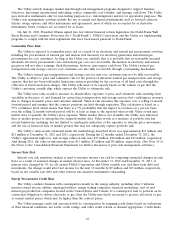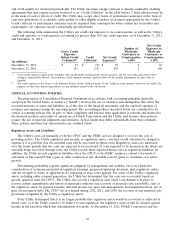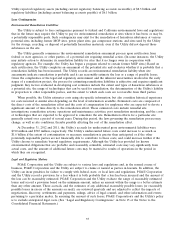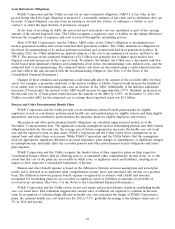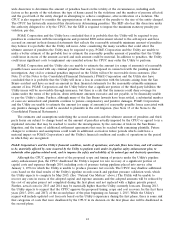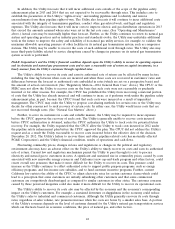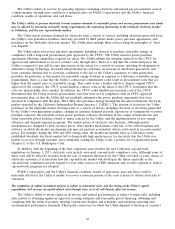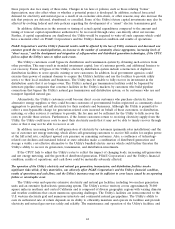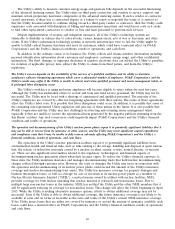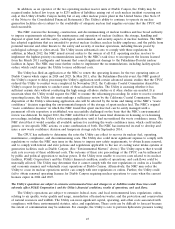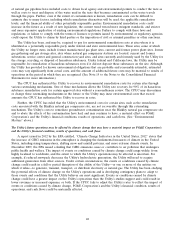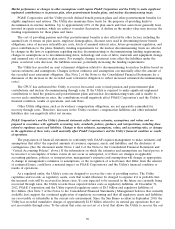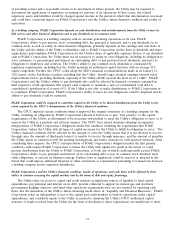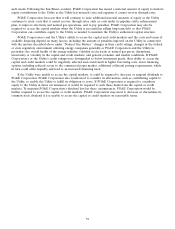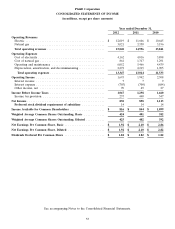PG&E 2012 Annual Report Download - page 49
Download and view the complete annual report
Please find page 49 of the 2012 PG&E annual report below. You can navigate through the pages in the report by either clicking on the pages listed below, or by using the keyword search tool below to find specific information within the annual report.the facilities of third parties on which the Utility relies, involve numerous risks, including the risks discussed
elsewhere in this section and those that arise from:
• the breakdown or failure of equipment, electric transmission or distribution lines, or natural gas transmission
and distribution pipelines, that can cause explosions, fires, or other catastrophic events;
• the failure of generation facilities to perform at expected or at contracted levels of output or efficiency;
• the failure of a large dam or other major hydroelectric facility;
• the failure to take expeditious or sufficient action to mitigate operating conditions, facilities, or equipment,
that the Utility has identified, or reasonably should have identified, as unsafe, which failure then leads to a
catastrophic event;
• severe weather events such as storms, tornadoes, floods, drought, earthquakes, tsunamis, wildland and other
fires, pandemics, solar events, electromagnetic events, or other natural disasters;
• operator or other human error;
• fuel supply interruptions or the lack of available fuel which reduces or eliminates the Utility’s ability to
provide electricity and/or natural gas service;
• the release of hazardous or toxic substances into the air or water;
• use of new or unproven technologies;
• cyber-attack; and
• acts of terrorism, vandalism, or war.
The occurrence of any of these events could affect demand for electricity or natural gas; cause unplanned
outages or reduce generating output which may require the Utility to incur costs to purchase replacement power;
cause damage to the Utility’s assets or operations requiring the Utility to incur unplanned expenses to respond to
emergencies and make repairs; damage the assets or operations of third parties on which the Utility relies; subject
the Utility to claims by customers or third parties for damages to property, personal injury, or wrongful death, or
subject the Utility to penalties. These costs may not be recoverable through rates or insurance. Insurance, equipment
warranties, or other contractual indemnification requirements may not be sufficient or effective to provide full or
even partial recovery under all circumstances or against all hazards or liabilities to which the Utility may become
subject. An uninsured loss could have a material effect on PG&E Corporation’s and the Utility’s financial condition,
results of operations, and cash flows. Future insurance coverage may not be available at rates and on terms as
favorable as the rates and terms of the Utility’s current insurance coverage or may not be available at all.
The Utility’s operational and information systems on which it relies to conduct its business and serve customers could fail to
function properly due to technological problems, a cyber-attack, acts of terrorism, severe weather, a solar event, an
electromagnetic event, a natural disaster, the age and condition of information technology assets, human error, or other
reasons, that could disrupt the Utility’s operations and cause the Utility to incur unanticipated losses and expense.
The operation of the Utility’s extensive electricity and natural gas systems rely on evolving information and
operational technology systems and network infrastructures that are becoming more complex as new technologies and
systems are implemented to modernize capabilities to safely and reliably deliver gas and electric services. The
Utility’s business is highly dependent on its ability to process and monitor, on a daily basis, a very large number of
tasks and transactions, many of which are highly complex. The failure of the Utility’s information and operational
systems and networks could significantly disrupt operations; result in public and employee safety lapse; result in
outages; reduced generating output; damage to the Utility’s assets or operations or those of third parties; and subject
the Utility to claims by customers or third parties, any of which could have a material effect on PG&E Corporation’s
and the Utility’s financial condition, results of operations, and cash flows.
The Utility’s systems, including its financial information, operational systems, advanced metering, and billing
systems, require constant maintenance, modification, and updating, which can be costly and increases the risk of
errors and malfunction. Any disruptions or deficiencies in existing systems, or disruptions, delays or deficiencies in
the modification or implementation of new systems, could result in increased costs, the inability to track or collect
revenues, the diversion of management’s and employees’ attention and resources, and could negatively affect the
effectiveness of the companies’ control environment, and/or the companies’ ability to timely file required regulatory
reports.
45


